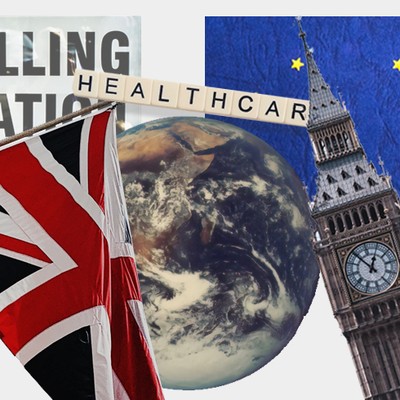
General Election: The Major Parties & Their Policies
CONSERVATIVES
Leader: Boris Johnson
Brexit
Since Boris Johnson replaced Theresa May in July, his focus has been on delivering Brexit as soon as possible. He has so far failed to meet two self-imposed deadlines. Now he is promising to ‘get Brexit done’ in January – if he wins a majority and gets his already-agreed deal through Parliament before Christmas. He reckons he can then strike a trade deal with the EU sometime next year, with a post-Brexit ‘transition’ period lasting no longer than December 2020. This timeline is regarded as optimistic by some.
NHS
The Conservatives want an extra £20.5bn in NHS funding in England by 2023-24; 50 million more GP appointments; and 50,000 more nurses. That’s on top of building a lot more hospitals and tackling the social care crisis too. Boris has called it the “biggest ever cash boost” to the NHS, although quite where the money might come from is still unclear. He has dismissed fears the health service could be put up for sale as part of a new US trade deal.
Climate Change
The Tories have promised: net-zero emissions by 2050; £9.2bn to improve the energy efficiency of homes, schools and hospitals; a ban on the export of plastic waste to developing countries; and a continued ban on fracking until it becomes safer. The party also wants to plant 75,000 acres of new trees a year, but environment analyst Roger Harrabin says the Tories’ climate policies are likely to “attract scrutiny”. Among all the major parties, their emissions deadline is by far the latest.
Taxes
A “triple tax lock” means the Tories are ruling out any significant increases in the headline rates of income tax, national insurance and VAT for five years. They say the state pension will increase by CPI measure of inflation, wage growth or 2.5% each year – whichever is the highest – with the national insurance threshold rising to £9,500 next year – saving workers around £100 a year. A plan to lift the income-tax threshold for middle-earners to £80,000 has been scrapped after Johnson said it “was not the time”.
Social Welfare
The Conservatives are determined to continue rolling out universal credit, despite the controversy surrounding the new benefits scheme, while re-evaluating disability benefits. When it comes to immigration, the Tories favour an Australian-style points system. A pledge to create 250,000 extra childcare places during the holidays for primary school-age children could cost £250m annually over the next three years. Elsewhere, student fees will stay as they are, while the party aims to help the most disadvantaged improve their homes to make them safer and more energy efficient.
LABOUR
Leader: Jeremy Corbyn
Brexit
Labour wants to renegotiate a new Brexit deal within three months, before holding another referendum within the next six months. In this second referendum, voters would choose between backing the deal and staying in the EU. Labour also wants to give EU nationals the right to remain, meaning EU citizens in the UK would no longer have to apply to continue living and working in the country ahead of Brexit.
NHS
Labour has pledged to increase the national health budget by 4.3%, while also limiting the amount of private provision in the NHS, so that more operations are done in public hospitals. It has also pledged to scrap prescription charges and some hospital car-parking fees. Labour’s manifesto also detailed major plans for a National Care Service to provide free personal care for older people who need help with day-to-day tasks.
Quite how it intends to raise the money remains a bit of a mystery, but the idea is that a higher income tax on earners above £80,000 might do the trick. Even so, The Institute for Fiscal Studies (IFS) reckons spending under Labour would reach a peak of more than £143bn by 2023.
Climate Change
Unlike the Tories, Labour has brought forward its net-zero carbon deadline to “within” the decade of 2030, aligning itself much more closely with targets laid out by the Greens. It also wants to create more than a million new jobs in the energy sector as part of a ‘green industrial revolution’, although spending commitments, exact deadlines and any kind of detailed plan remains unclear for now.
Taxes
The Labour manifesto included a tax increase for Britain’s highest earners – all those earning over £80,000 – with income tax and national insurance frozen for everyone else. Labour is also promising all workers over 16 years old a minimum wage of £10 an hour within the next year. The party is also promising workers longer maternity and paternity pay, and guaranteed bereavement pay, while keeping the pension age at 66. It’s hoped that forcing richer citizens to hand over more of their money to the Treasury will help fund its vision for the NHS and climate change.
Social Welfare
Labour wants to scrap universal credit and introduce a whole new benefits system, although quite what that will look like is yet to be announced. It wants to remove the charitable status of private schools and get rid of all university tuition fees. Instead of tuition fees, it has pledged to restore maintenance grants to give the poorest students access to higher education. Early estimates show the plans for education reforms could cost somewhere in the region of £12bn. Elsewhere, Labour wants to bring the railways back into public ownership, allow free bus travel for under-25s and build more than 100,000 new council houses every year. Nationalisation is a cornerstone of the party’s manifesto and could see companies like BT and Royal Mail brought back into public hands.
LIBERAL DEMOCRATS
Leader: Jo Swinson
Brexit
If they win the general election, the Liberal Democrats would stop the Brexit process without holding another referendum, revoke Article 50 and remain in the EU for the foreseeable future. Leader Jo Swinson says that staying in the EU could deliver a whopping £50bn ‘remain bonus’, which would then be redirected towards public services.
NHS
The Lib Dems’ goal is to raise £7bn a year over the next five years – a total of £35bn – and spend it on improving NHS services and social care. They plan to raise the money from a higher charge on income tax – essentially a penny in every pound – although critics believe it will be difficult to track exactly where the money will be spent. As a possible solution to this problem, Lib Dems are targeting a dedicated health and care tax to make sure voters’ money goes towards key public services.
Climate Change
Deputy leader Sir Ed Davey has said his party will spend up to £100bn tackling the climate emergency and reducing carbon emissions by 2045. The party also wants to generate more than 80% of the nation’s electricity from renewable sources by 2030, which will involve rapid development of more wind turbines and solar farms. The Greens aside, the Lib Dems are the party with the nearest-term targets for improving climate policies in the UK.
Taxes
The Lib Dems are the only party pledging a rise in the basic rate of tax, which they would use to fund their visions for the NHS, climate change and social welfare. The party wants to tax frequent flyers to help the environment Elsewhere, it would boost the higher minimum wage for people working on zero-hours contracts and raise the tax paid by businesses to help fund free childcare and school-meal schemes.
Social Welfare
The Lib Dems want to build 300,000 new homes a year in Britain helped in part by – you guessed it – specific changes to the tax system. Similar to Help to Buy, the party wants to introduce a Help to Rent scheme to help tenants with upfront deposits. Refugees are a big part of the Lib Dem manifesto, with the party aiming to resettle 10,000 unaccompanied refugee children in the UK over the next decade. Other policies include legalising cannabis, freezing train fares, providing more free childcare across the country and recruiting thousands more teachers.
GREENS
Leaders: Jonathan Bartley & Siân Berry
Brexit
The Greens are committed to staying in the EU and want to offer voters a second referendum to give them a chance to remain. However, even if the public voted to leave a second time, the Greens have said they are committed to membership of the single market.
NHS
Under the Greens, funding for the NHS would rise by £6bn a year until 2030, with a further £1bn per year funding higher education for nurses. It would aim to fund this mainly through tax rises, many of which focus on the environment.
Like Labour, it also wants to dramatically reduce the reliance of Britain’s healthcare industry on the private sector, and might even push for further devolution of healthcare services into local communities. When it comes to social care, the Greens want to pour up to £4.5bn into making sure elderly people are looked after.
Climate Change
Buckle up, because this is where the Greens mean business. The party will spend £100bn to cut carbon emissions completely by 2030, and spend possibly trillions in the long term to make sure that fossil fuels are removed entirely from the UK economy.
Carbon taxes will apply to all oil and gas extraction activity, while frequent flyers will face a levy. Petrol and diesel cars will also be phased out by 2030, with thousands of new jobs created across new clean and green industries.
Also by 2030, the Greens aim to plant more than 700 million trees, while encouraging farmers to adopt greener working practices. People living in the UK will also be encouraged to reduce meat in their diets, while local councils will be given the power to build carbon-neutral homes. Millions of houses up and down the country will also be encouraged to use energy more efficiently. Finally, the plastic-bag tax will be extended to apply to plastic bottles, single-use plastics and microplastics.
Taxes
The Greens aim to fund their vision for a carbon-neutral world primarily via changes to the tax system – not unlike the Lib Dems. However, they also want to simplify the current systems dramatically by merging national insurance, capital gains tax, inheritance tax, dividend tax and income tax into a single consolidated income tax. In the party’s view, this would mean all income is treated the same way, regardless of whether it comes from investments assets or work, and could bring £20bn extra per year into the Treasury.
Social Welfare
Like Labour, the Green Party wants to scrap university tuition fees, as well as write off all the debt owed by students who paid £9,000 a year – a policy which could cost around £33bn. For those in work, the party wants to introduce a universal basic income of £89 a week for everyone, regardless of how much money they earn, by 2025. There would also be extra handed out to families with children and pensioners, which could add another £86bn on top of current benefit spending of £256bn. The plan would largely be funded via a tax on carbon emissions and removing the income-tax personal allowance.
DISCLAIMER: We endeavour to always credit the correct original source of every image we use. If you think a credit may be incorrect, please contact us at info@sheerluxe.com.






















